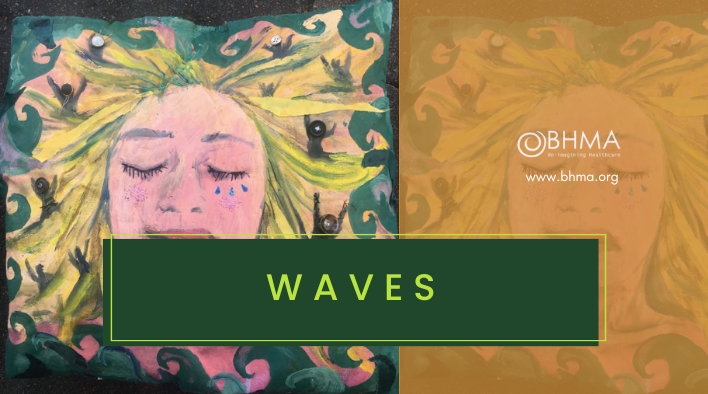Waves
Freya Elliott, Artist and medical student, Barts and The London School of Medicine and Dentistry
Published in JHH18.1 – Flourishing in Medical Education
Before starting medical school I was a producer at Camden People’s Theatre, and a freelance puppet/props/model maker. I initially studied fine art at Oxford University, then an MA visual media for performance at Central School of Speech and Drama. When not studying I mainly paint and draw but also make films and animations. I am interested in how creative enquiry.
During my time as a medical student I have witnessed many moving and uplifting clinical experiences, but also many troubling and upsetting ones. Being part of the medical field is like having a backstage pass on humanity. You get a glimpse into the lives, thoughts, bodies of a wide variety of individuals. You learn about how magnificently resilient and amazing human beings can be, but you also witness how much pain people can experience in their lives. When I first started medical school I found some placement experiences quite difficult to process.
To explore these ideas further I painted and embroidered a pillow depicting a woman (opposite). The waves of her hair form a sea, in which silhouetted anonymous people are waving for help. Some look like they are drowning. The woman represents the medical practitioner and the people represent the patients. I was trying to explore how medical practitioners, particularly GPs who look after people over many years, can be greatly affected by their patients and worry about them, especially at the end of the day when their head is on the pillow at night.
As Jennifer Best (2016) writes:
‘Even more than a decade from residency, I am pierced by these tragic moments and faces – each still heart-shatteringly vivid…’
On the pillow, the people waving for help represent patients who the doctor cannot help, their problems unresolved, tangled in her hair, still a troubling presence in the doctor’s mind. Or perhaps they are patients with medically unexplained symptoms? Or perhaps patients who have died, and who a doctor fears they could have done more for? Doctors work with life and death daily and being responsible for another human’s life is a huge responsibility. The weight of this responsibility can be extremely stressful and detrimental to the mental health of doctors. On my course we have been warned about the risks of burnout. This work is meant to explore how difficult it can be for doctors to process some of the upsetting moments they encounter in their daily work.
In creating this pillow, I also wanted to include the positive aspects of being a doctor. If you cover one side of the face, the woman is crying, which is meant to represent anguish. However, if you cover the other side of the pillow the woman looks quite content when she sleeps. This was meant to reflect the other side of the profession, the great satisfaction from being a doctor and knowing you have made a positive difference to someone’s life.
I enjoyed making this piece of work. It gave me the opportunity to respond visually to thoughts and experiences I have had during my training as a medical student so far, and I found the process of making it therapeutic.
Reference
- Best JA (2016) The things we have lost. JAMA, 316 (18)1871–1872. doi:10.1001/jama.2016.9954.







